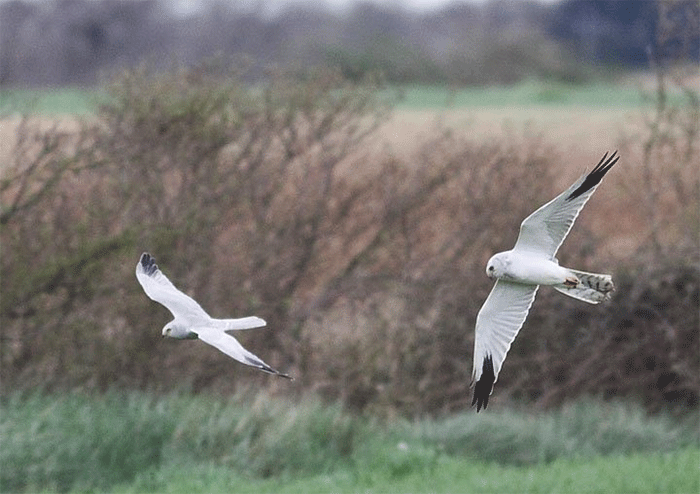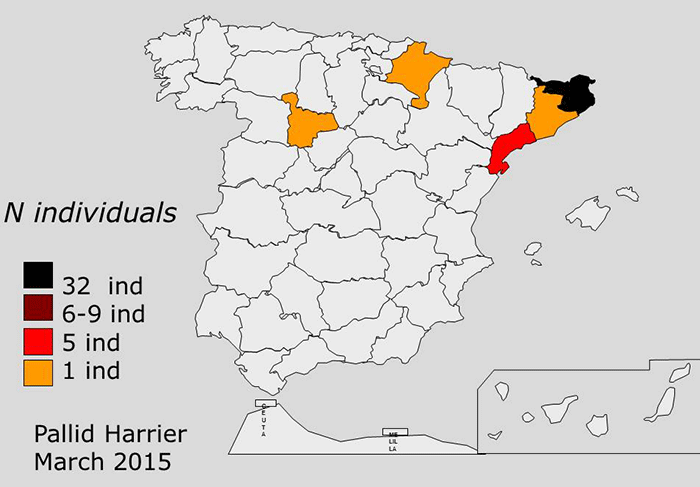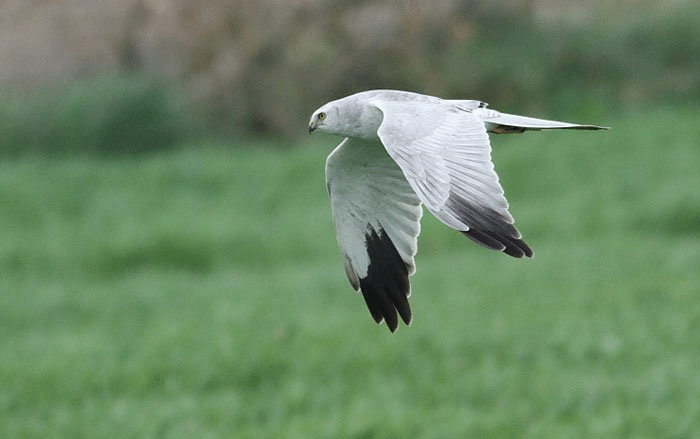Pallid Harrier influx in NE Iberia in March 2015
Àlex Ollé and Ricard Gutiérrez (www.rarebirdspain.net)

From the 20th of March and until early April, there have been at least 40 different individuals of Pallid Harrier Circus macrourus in mainland Spain. Most of the birds (95%) were recorded in Catalonia (NE Iberia), and amongst these 32 at Girona province, all in the easternmost counties of the coastal plains of l’Empordà and Gironès – La Selva, flat areas favored by a higher proportion of eastern migrants in comparison with other Catalonia, not to mention Iberia, sites (figure 1). Single birds were seen at Navarra and Valladolid, all in the N half of Spain. These figures are unprecedented in Spain for a single month and may have been caused by weather conditions bringing birds to Spain from their more eastern migrant routes. But there might be an emerging pattern behind as well.

Males on their way
All harriers, but a 2nd calendar-year male and an adult female seen on 25 March, have been 3rd calendar-year or older males. This high proportion of males is explained because of the beginning of the northbound migration of the species from Africa in late March. And because of the males are the first to attempt it since they are in charge of establishing their breeding territories, being therefore the first to arrive to their European breeding sites. Females tend to begin migration some days, even weeks, later and they are normally not recorded in Spain until early April. First winters (2nd calendar-year) are the latest migrants because they have no breeding need and therefore they are in no hurry compared with migrant adults.
This pattern is also similarly recorded in the Messina strait, Italy, the place where the highest Pallid Harrier flux from Africa into Europe is regularly recorded. The species is still considered a rarity in Spain (despite recent figures) and has begun overwintering in Andalusia, S Spain a few winters ago. Indeed, this recent overwintering pattern may have shadowed a bit the migration phenology pattern of the species in Spain: some 2nd calendar years are now seen earlier than the usual these being, perhaps, Iberian wintering birds rather than true long-distance migrants.

Predictable sites, emerging pattern
It is becoming increasingly frequent that birds recorded within these influxes, involving up to some tens of birds along the country, are concentrated only in a few key areas. Bad weather force birds to stop on their migration. And as it happens with other migrant harriers, selected suitable habitat areas can hold up to a few birds altogether. These places may show repeated observations one year after another and this better knowledge has also helped to predict hence quantify the phenomenon, given it is produced, even having two or three birds at the same roost.
Are these influxes something that has always happened and might have gone undetected? It rather seems to be a recent phenomenon, with 2015 beating any known overall figure for the species in Spain.
As stated above, spring migration records in Iberia range from mid-March to mid-May (figure 2)
Until 2011, a grand total of 53 birds have been homologated in Spain by the Rarities Committee. However, at least 182 more birds (until 2014) have been either not sent to the Committee or remain pending acceptance. Most of these records have been exponentially produced in the last ten years (figure 3), matching the increase of the species in Iberia. This increase recommends a reassessment of the status of the species as rarity too.

To reinforce the thesis that something else beyond weather drifting bringing birds to the coast is happening it is important to remember that the species is no longer only recorded in spring. Until 2004, 86% of the sightings were spring records. But from 2011-2013 the spring quote got reduced to a 46%. This change shows how autumn and winter records have increased the last years. Increase of observer skills may have played a role, but there is also a real change in the distribution of the species in N Europe and the establishment of a new western-bound migration route for the species behind this pattern.
The unprecedented 40 Pallid Harriers recorded in only 8 days in late March 2015 have probably reached N Iberia due to heavy eastern winds reaching the area during the peak migration season of the species, caused by a low pressure system located S of the Balearics (figure 4). Those winds would have drifted west the birds from their usual central Mediterranean routes and similar situations in the past have brought similar high numbers of Collared Flycatchers to the same area (see http://rarebirdspain.blogspot.com/2013/04/invasion-de-papamoscas-collarinos.html for details). But the changing pattern of the migration, overwintering and even breeding distribution of the species all over Europe may deserve in the future more not only regular sightings, but amazing shows such as those recorded this March in some places in NE Iberia.

Àlex Ollé and Ricard Gutiérrez
www.rarebirdspain.net
07 April 2015





